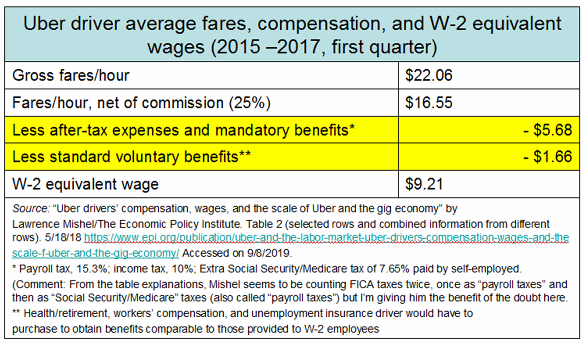The Headlines
“Uber drivers earn the equivalent of $9.21 in hourly wages” The Economic Policy Institute May 7, 2019
“This is how much Uber drivers really make” Maria LaMagna/Market Watch May 15, 2018
“Study finds Uber drivers make less than minimum wage” Levi Sumagaysay/Mercury News May 18, 2018
The Story
All these headlines refer to a report by Lawrence Mishel of the Economic Policy Institute in May 2018. Mishel came up with the "equivalent of $9.21 in hourly wages”. Here’s a simplified version of how Mishel came up with his $9.21 figure:
First thing I notice is that Mishel didn’t Incorporate tax deductions in determining what Uber drivers earn. He acknowledges this and explains:
“If an Uber driver used [the] standard expense deduction of $0.54 per mile [2016 rate], this would average $10.80 an hour (at 20 miles driven per hour) rather than the actual expense of $6.40 an hour. This would confer a tax benefit of $1.11 an hour…That implies a sizable boost to a driver’s bottom line…Wage comparisons do not regularly incorporate tax consequences, such as including the implied earned income tax credit, when comparing occupational wage differences.”
Excuse me, but if you’re going to compare the earnings of independent contractors and employees, you have to consider the tax consequences of being an independent contractor. Why? Because they get very generous expense deductions by virtue of being self-employed. And if you’re referring to the wage of an employee, then you need to also indicate the pre-tax gross wage. After all, political arguments for a higher minimum or living wage always use the pre-tax wage as the aspirational reference point, e.g. $15 an hour (which would be roughly $12.51 an hour after taxes).
Mishel’s $9.21 refers to the after-tax W-2 wage but to have a take-home wage of $9.21 per hour, the gross wage would be somewhere between $10-$11 per hour. Which doesn’t sound quite so bad. If Mishel had used the pre-tax W-2 wage as the point of comparison, we probably would have fewer articles claiming Uber drivers make minimum wage or less.
Also, most Uber drivers work in cities and their environs, which vary in fare rate and expenses. To make sweeping statements about what Uber drivers earn in the US as a whole glosses over a whole lot of variation. Luckily, a recent study (Hall and Krueger, 2018) provided rates for different cities. So let’s compare the US with San Francisco and do the right calculations:
Ok, I’m not an accountant or Enrolled Agent but I did run a career counseling business for years and advised clients on starting businesses, including the tax implications. So I’m pretty confident of the above figures, give or take. Yes, I note the irony that my estimate of net earnings is somewhat less than what Mishel came up with. That’s the type of thing that happens when you pursue a subject in the spirit of exploration, when the destination isn’t known in advance.
My Take-Away:
The average Uber driver makes considerably more than minimum wage in almost all states*, not great but also not bad for a while, especially for the young, near-old, and parents looking for extra money. It’s not a career job, though, unless you’re really good at it, work in an optimal location, and get decent tips.
—
* Note: San Francisco just raised its minimum wage to $15.59/hr, so based on my calculations the average Uber driver in San Francisco would not make the local minimum wage. In expensive cities like SF, rideshare driver pay floors might be justified to minimize abuse of independent contractors. New York City implemented such a pay floor last December. So far prices have gone up and the number of drivers have gone down as the rideshare companies adjust to the new reality.
References:
Hall, J. V., & Krueger, A. B. (2018). An Analysis of the Labor Market for Uber’s Driver-Partners in the United States . ILR Review, 71(3), 705–732. https://doi.org/10.1177/0019793917717222
Mishel, Lawrence “Uber drivers’ compensation, wages, and the scale of Uber and the gig economy” The Economic Policy Institute. May 18, 2018
Zoepf, Stephen, Stella Chen, Paa Adu, and Gonzalo Pozo. 2018. The Economics of Ride Hailing: Driver Expenses, Income and Taxes. MIT Center for Energy and Environmental Policy Research, February 2018

